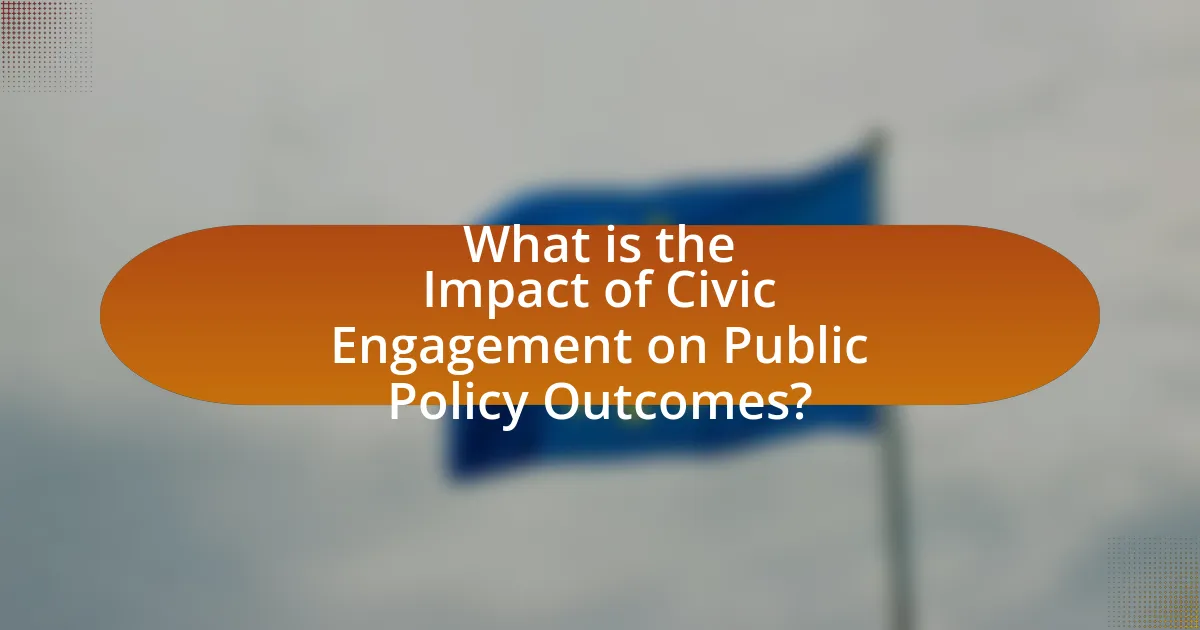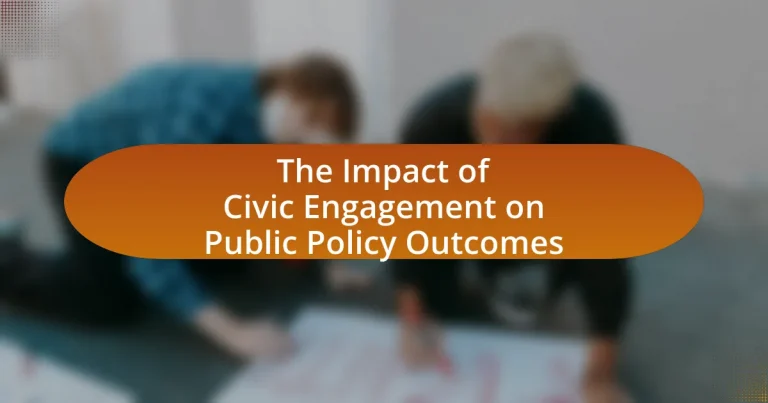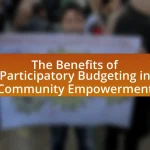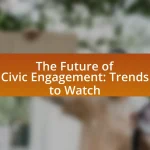Civic engagement plays a crucial role in shaping public policy outcomes by enhancing democratic participation and ensuring diverse community voices are heard. Active participation in civic activities, such as voting and advocacy, leads to more responsive governance and policies that reflect community needs. The article explores the mechanisms through which civic engagement influences policy decisions, the varying impacts of different forms of engagement, and the importance of civic participation for effective governance. It also addresses challenges to civic engagement, socio-economic factors affecting participation levels, and strategies to enhance civic involvement in public policy. Additionally, the article highlights successful case studies and future trends in civic engagement, emphasizing the role of technology and changing demographics in shaping civic practices.

What is the Impact of Civic Engagement on Public Policy Outcomes?
Civic engagement significantly influences public policy outcomes by enhancing democratic participation and ensuring that diverse community voices are heard. When citizens actively participate in civic activities, such as voting, attending town hall meetings, or engaging in advocacy, they can shape policy decisions that reflect their needs and priorities. Research indicates that areas with higher levels of civic engagement often experience more responsive governance and policies that align with the public’s interests. For instance, a study by the National Civic League found that communities with robust civic engagement initiatives saw improved public services and increased trust in government, demonstrating a direct correlation between citizen involvement and effective policy outcomes.
How does civic engagement influence public policy decisions?
Civic engagement significantly influences public policy decisions by fostering active participation from citizens in the political process. When individuals engage in civic activities such as voting, attending town hall meetings, or participating in advocacy groups, they provide policymakers with insights into community needs and preferences. For instance, a study by the Pew Research Center found that communities with higher levels of civic engagement tend to have policies that better reflect the interests of their residents, as engaged citizens are more likely to communicate their concerns and priorities to elected officials. This interaction can lead to more responsive governance and the implementation of policies that address specific local issues, thereby enhancing the overall effectiveness of public policy.
What are the key mechanisms through which civic engagement affects policy outcomes?
Civic engagement affects policy outcomes primarily through mechanisms such as advocacy, public opinion shaping, and participatory governance. Advocacy allows citizens to influence decision-makers by mobilizing support for specific issues, as seen in movements like the Civil Rights Movement, which led to significant legislative changes. Public opinion shaping occurs when engaged citizens express their views, prompting policymakers to consider these perspectives in their decisions; for example, public protests against climate change have led to increased governmental action on environmental policies. Participatory governance involves citizens directly in the policymaking process, enhancing transparency and accountability, as demonstrated by participatory budgeting initiatives in cities like Porto Alegre, Brazil, which have resulted in more equitable resource allocation. These mechanisms collectively demonstrate how civic engagement can lead to meaningful changes in public policy.
How do different forms of civic engagement vary in their impact on policy?
Different forms of civic engagement, such as voting, advocacy, and community organizing, vary significantly in their impact on policy. Voting directly influences electoral outcomes and shapes the composition of legislative bodies, as evidenced by the 2020 U.S. presidential election, where voter turnout reached 66.8%, leading to substantial policy shifts. Advocacy, through lobbying and public campaigns, can sway policymakers by highlighting specific issues, demonstrated by the successful push for the Affordable Care Act, which involved extensive grassroots mobilization. Community organizing fosters local participation and can lead to policy changes at municipal levels, as seen in the Fight for $15 movement, which resulted in minimum wage increases in several cities. Each form of engagement mobilizes different resources and strategies, thus affecting policy outcomes in unique ways.
Why is civic engagement important for effective governance?
Civic engagement is crucial for effective governance because it fosters accountability and enhances the responsiveness of public officials to the needs of the community. When citizens actively participate in governance processes, such as voting, attending town hall meetings, or engaging in public discussions, they provide valuable feedback that helps shape policies and decisions. Research indicates that communities with higher levels of civic engagement experience better public policy outcomes, as evidenced by a study from the National Civic League, which found that engaged citizens are more likely to influence local government decisions and improve service delivery. This active participation leads to a more informed electorate and promotes transparency, ultimately strengthening democratic processes and ensuring that governance reflects the will of the people.
What role does civic engagement play in enhancing democratic processes?
Civic engagement plays a crucial role in enhancing democratic processes by fostering active participation and representation among citizens. When individuals engage in civic activities, such as voting, attending town hall meetings, or participating in community organizations, they contribute to a more informed electorate and hold elected officials accountable. Research indicates that higher levels of civic engagement correlate with increased voter turnout and more responsive governance. For instance, a study by the Pew Research Center found that communities with robust civic engagement initiatives experience greater political participation and improved public policy outcomes, demonstrating the direct impact of citizen involvement on the effectiveness of democracy.
How does civic engagement contribute to accountability in public policy?
Civic engagement enhances accountability in public policy by fostering transparency and encouraging citizen participation in decision-making processes. When citizens actively engage in civic activities, such as voting, attending town hall meetings, or participating in advocacy groups, they hold public officials accountable for their actions and policies. Research indicates that communities with higher levels of civic engagement experience more responsive governance, as elected officials are more likely to consider the needs and opinions of an active electorate. For instance, a study by the National Civic League found that cities with robust civic engagement initiatives reported improved public trust and satisfaction with local government performance. This correlation demonstrates that civic engagement is a critical mechanism for ensuring that public policies reflect the will of the people and that officials are answerable to their constituents.
What challenges does civic engagement face in influencing public policy?
Civic engagement faces significant challenges in influencing public policy, primarily due to systemic barriers, lack of resources, and political apathy. Systemic barriers include institutional resistance to change, where established political structures may prioritize elite interests over public input, limiting the effectiveness of civic initiatives. Additionally, many civic engagement efforts lack adequate funding and organizational support, which hampers their ability to mobilize communities and sustain long-term advocacy. Political apathy among the electorate further complicates these efforts, as low voter turnout and disengagement reduce the pressure on policymakers to respond to civic demands. According to a report by the National Civic League, only 27% of Americans feel that their voices are heard in government, highlighting the disconnect between civic engagement and policy influence.
What barriers prevent effective civic participation in policy-making?
Barriers that prevent effective civic participation in policy-making include lack of access to information, socioeconomic disparities, and institutional obstacles. Lack of access to information limits citizens’ understanding of policy issues, as studies show that informed citizens are more likely to engage in the policy process. Socioeconomic disparities create unequal opportunities for participation, with lower-income individuals often facing challenges such as time constraints and lack of resources to engage effectively. Institutional obstacles, such as bureaucratic processes and complex regulations, can further discourage participation by making it difficult for citizens to navigate the policy-making landscape. These barriers collectively hinder the ability of diverse populations to influence public policy outcomes.
How do socio-economic factors affect civic engagement levels?
Socio-economic factors significantly influence civic engagement levels by determining individuals’ access to resources, education, and social networks. Higher income and education levels correlate with increased participation in civic activities, such as voting and community organizing. For instance, a study by the Pew Research Center found that individuals with a college degree are more likely to vote compared to those without, highlighting the role of education in fostering civic involvement. Additionally, socio-economic status affects individuals’ perceptions of their ability to influence political processes, with those in lower socio-economic brackets often feeling disenfranchised, which can lead to lower engagement levels.
How can civic engagement be effectively measured?
Civic engagement can be effectively measured through a combination of quantitative and qualitative methods, including surveys, participation rates, and analysis of public discourse. Surveys can assess individuals’ self-reported levels of engagement, such as voting, attending town hall meetings, or participating in community service. Participation rates in elections and civic activities provide concrete data on how many individuals are actively involved in civic life. Additionally, analyzing public discourse through social media and community forums can reveal the nature and frequency of civic discussions, reflecting the engagement levels within a community. Research by the Pew Research Center indicates that higher civic engagement correlates with increased voter turnout and community involvement, demonstrating the effectiveness of these measurement methods.
What indicators are used to assess the level of civic engagement?
Indicators used to assess the level of civic engagement include voter turnout, participation in community organizations, and involvement in public meetings. Voter turnout reflects the percentage of eligible voters who cast ballots in elections, serving as a direct measure of political participation. Participation in community organizations indicates the extent to which individuals engage in local initiatives, fostering social connections and collective action. Involvement in public meetings, such as town halls or city council sessions, demonstrates active interest in governance and policy-making processes. These indicators collectively provide a comprehensive view of civic engagement levels within a community.
How do these indicators correlate with public policy outcomes?
Indicators of civic engagement, such as voter turnout, public participation in community meetings, and advocacy efforts, correlate positively with public policy outcomes by influencing decision-making processes and policy effectiveness. For instance, higher voter turnout often leads to elected officials who prioritize constituents’ needs, resulting in policies that reflect public interests. Research by the Pew Research Center indicates that communities with active civic engagement see more responsive governance, as officials are more likely to address issues raised by engaged citizens. Additionally, studies show that public participation in policy discussions can lead to more informed and equitable outcomes, as diverse perspectives contribute to comprehensive policy development.
What strategies can enhance civic engagement in public policy?
Strategies that can enhance civic engagement in public policy include increasing access to information, fostering community dialogue, and utilizing technology for outreach. Increasing access to information ensures that citizens are well-informed about policy issues, which can be achieved through transparent government practices and educational initiatives. Fostering community dialogue encourages participation by creating platforms for discussion, such as town hall meetings and forums, where citizens can voice their opinions and concerns. Utilizing technology, such as social media and online surveys, allows for broader outreach and engagement, enabling citizens to participate in policy discussions conveniently. Research indicates that communities with higher levels of civic engagement tend to have better policy outcomes, as seen in studies conducted by the National Civic League, which highlight the correlation between active citizen participation and effective governance.
How can technology be leveraged to increase civic participation?
Technology can be leveraged to increase civic participation by providing accessible platforms for communication and engagement. Digital tools such as social media, mobile applications, and online forums facilitate real-time interaction between citizens and policymakers, enabling broader participation in discussions about public issues. For instance, a study by the Pew Research Center found that 69% of adults in the U.S. use social media, which can be utilized to mobilize community action and disseminate information about civic events. Additionally, online voting systems and e-petitions have been shown to enhance voter turnout and engagement, as evidenced by the increased participation rates in jurisdictions that implemented these technologies.
What role do educational initiatives play in fostering civic engagement?
Educational initiatives play a crucial role in fostering civic engagement by equipping individuals with the knowledge and skills necessary to participate actively in their communities. These initiatives often include programs that teach civic responsibility, critical thinking, and the importance of voting, which directly influence individuals’ willingness to engage in civic activities. For instance, research conducted by the Center for Information and Research on Civic Learning and Engagement (CIRCLE) indicates that students who participate in civic education programs are more likely to vote and engage in community service, demonstrating a clear link between education and civic participation.
What are the best practices for fostering civic engagement in communities?
The best practices for fostering civic engagement in communities include creating inclusive platforms for dialogue, providing accessible information, and encouraging participation in decision-making processes. Inclusive platforms, such as town hall meetings and community forums, allow diverse voices to be heard, which enhances representation and trust. Accessible information, including clear communication about local issues and governance, empowers citizens to make informed decisions. Encouraging participation in decision-making, such as through participatory budgeting or advisory councils, fosters a sense of ownership and responsibility among community members. Research shows that communities with higher civic engagement levels experience improved public policy outcomes, as evidenced by studies indicating that engaged citizens are more likely to advocate for policies that reflect their needs and values.
How can local governments encourage citizen involvement in policy-making?
Local governments can encourage citizen involvement in policy-making by implementing participatory budgeting processes. This approach allows citizens to directly influence how public funds are allocated, fostering a sense of ownership and engagement in local governance. Research from the Participatory Budgeting Project indicates that cities employing this method have seen increased civic participation and satisfaction with local government decisions. Additionally, local governments can host town hall meetings and workshops to solicit feedback on proposed policies, ensuring that community voices are heard and considered in decision-making.
What successful case studies illustrate effective civic engagement strategies?
Successful case studies illustrating effective civic engagement strategies include the “Participatory Budgeting” initiative in Porto Alegre, Brazil, and the “Neighborhood Councils” in Los Angeles, California. The Porto Alegre model, initiated in 1989, allowed citizens to directly influence budget allocations, resulting in increased public investment in health and education by over 20% and improved infrastructure in low-income areas. In Los Angeles, the Neighborhood Councils, established in 1999, empowered local communities to voice their concerns and priorities, leading to enhanced community services and increased civic participation, with over 90 councils representing diverse neighborhoods. These examples demonstrate how structured civic engagement can lead to tangible improvements in public policy and community well-being.
What are the future trends in civic engagement and public policy?
Future trends in civic engagement and public policy include increased digital participation, greater emphasis on inclusivity, and the rise of data-driven decision-making. Digital platforms are facilitating more accessible and widespread engagement, allowing citizens to participate in policy discussions and decision-making processes from anywhere. Research indicates that online civic engagement tools have led to higher participation rates, particularly among younger demographics. Additionally, there is a growing focus on ensuring that diverse voices are represented in public policy, which is supported by initiatives aimed at reducing barriers to participation for marginalized communities. Data-driven approaches are also becoming more prevalent, as policymakers increasingly rely on analytics to understand public sentiment and inform their decisions, enhancing the responsiveness of public policies to community needs.
How might changing demographics influence civic engagement practices?
Changing demographics significantly influence civic engagement practices by altering the composition and priorities of the population involved in civic activities. For instance, as younger generations become a larger segment of the population, there is a noticeable shift towards digital engagement methods, such as social media campaigns and online petitions, which are more aligned with their communication preferences. Research indicates that millennials and Gen Z are more likely to engage in activism through digital platforms, with 70% of young people reporting that they have participated in online advocacy (Pew Research Center, 2021). Additionally, increasing diversity in demographics leads to a broader range of perspectives and issues being prioritized, which can reshape community organizing efforts and policy advocacy. For example, communities with higher immigrant populations may focus on issues like immigration reform and social justice, thereby influencing local civic engagement strategies to address these specific concerns.
What emerging technologies could shape the future of civic participation?
Emerging technologies that could shape the future of civic participation include blockchain, artificial intelligence, and mobile applications. Blockchain technology can enhance transparency and trust in voting processes by providing secure, tamper-proof records of votes, as demonstrated in pilot projects in countries like Estonia. Artificial intelligence can analyze public sentiment and engagement patterns, enabling governments to tailor policies more effectively, as seen in various smart city initiatives. Mobile applications facilitate real-time communication between citizens and government officials, increasing accessibility and participation, evidenced by platforms like SeeClickFix that allow residents to report local issues directly. These technologies collectively foster greater civic engagement and influence public policy outcomes.
How can individuals effectively engage in civic activities to influence public policy?
Individuals can effectively engage in civic activities to influence public policy by participating in local government meetings, advocating for specific issues, and mobilizing community support. Engaging in local government meetings allows individuals to voice their concerns directly to policymakers, fostering dialogue and transparency. Advocacy efforts, such as writing letters to elected officials or organizing campaigns, can raise awareness about critical issues, as evidenced by the success of grassroots movements like the Civil Rights Movement, which significantly shaped legislation. Mobilizing community support through organizing events or utilizing social media can amplify voices and create a collective impact, demonstrated by the widespread participation in the Women’s March, which influenced public discourse and policy discussions.


